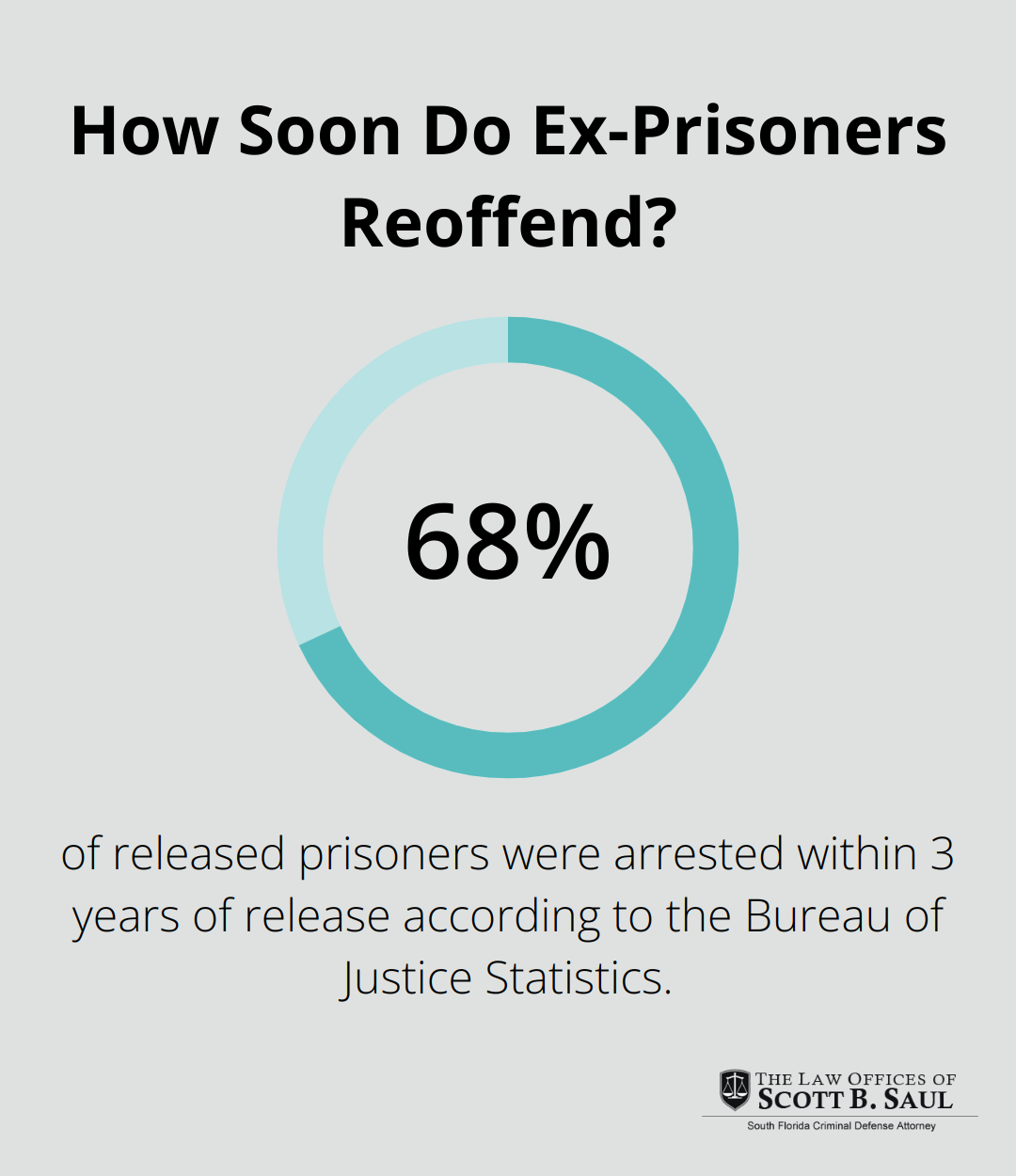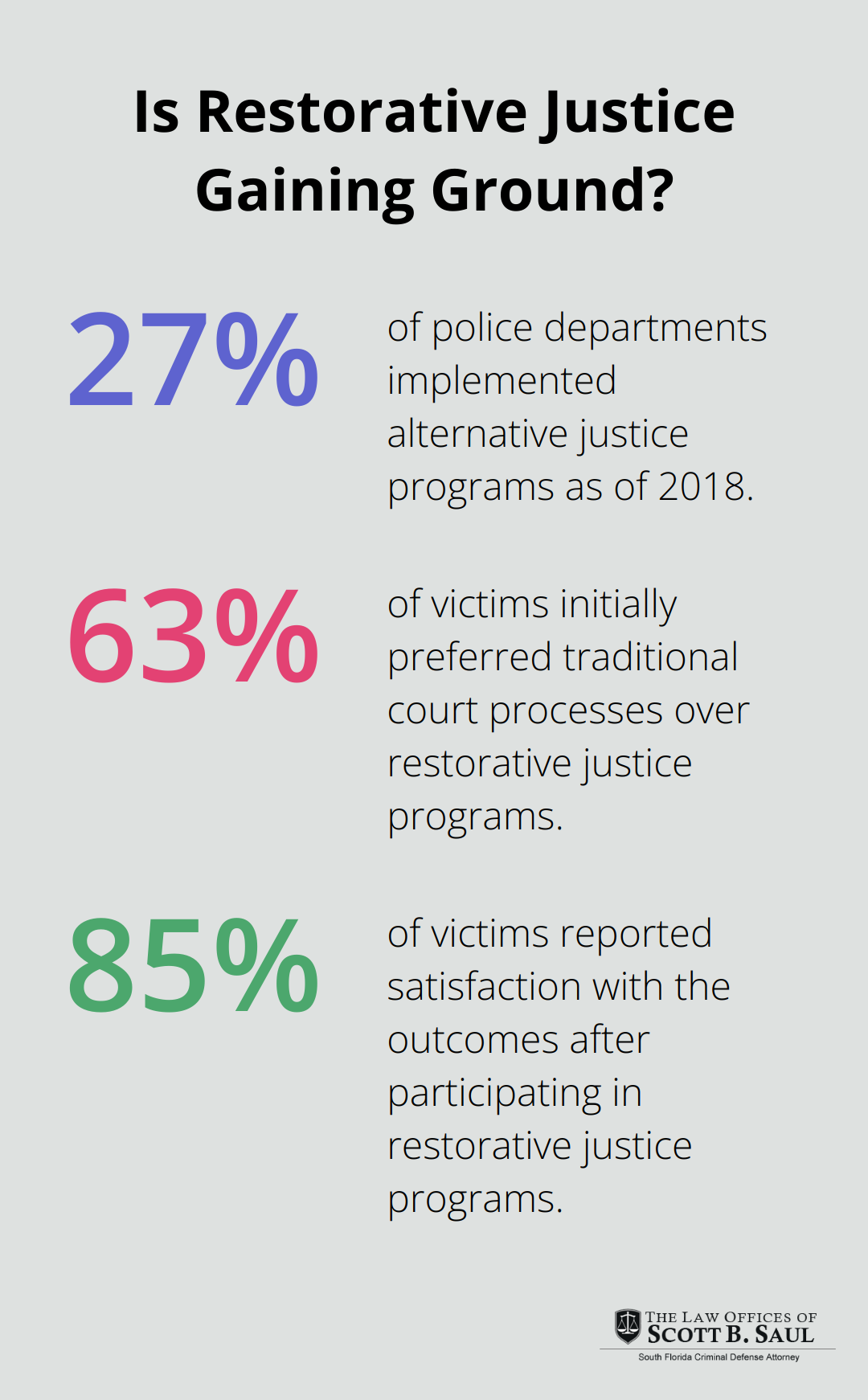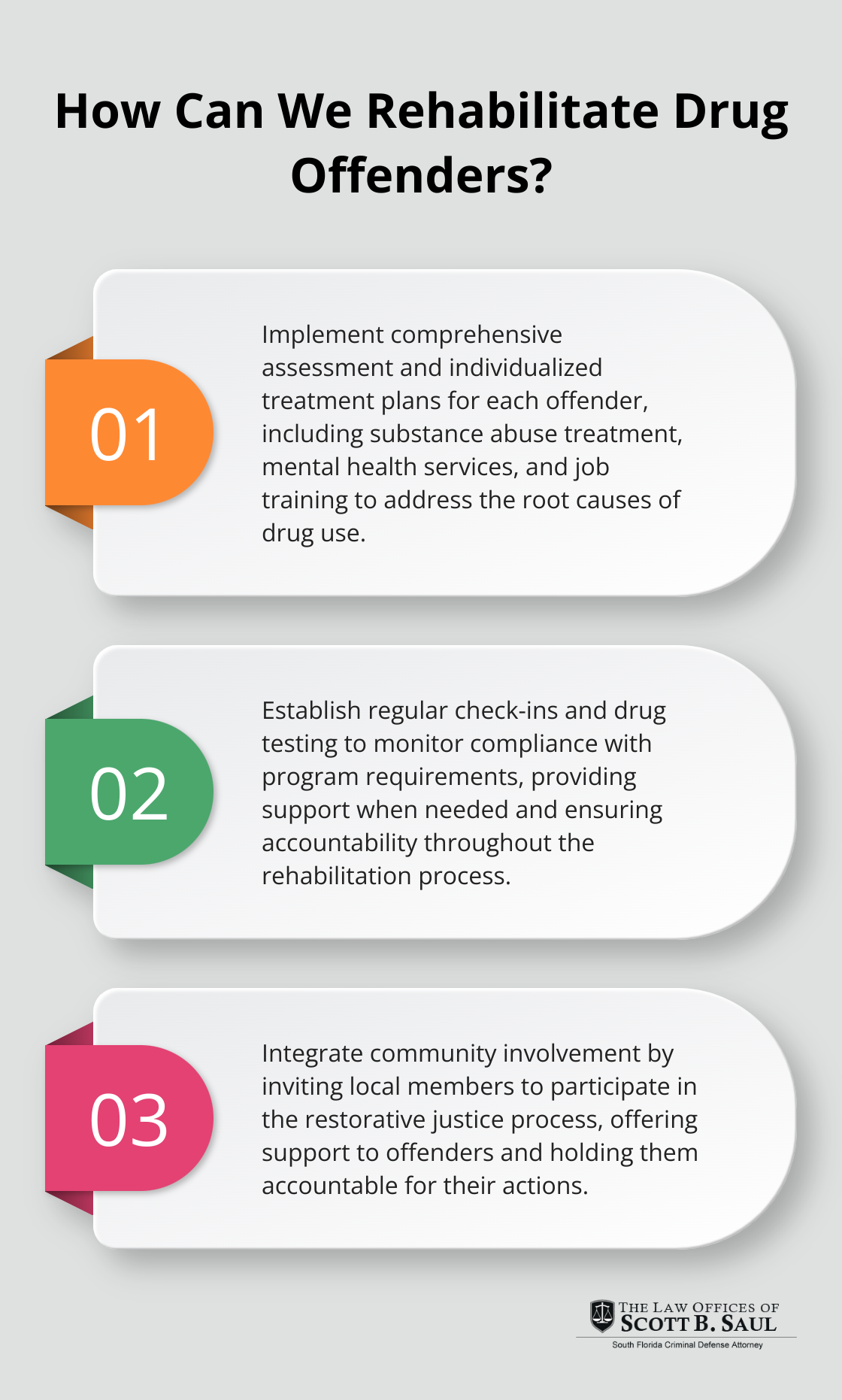Restorative Justice Approach to Drug Offenses
By : saulcrim | Category : Criminal Defense | Comments Off on Restorative Justice Approach to Drug Offenses
12th Dec 2024

At Law Offices of Scott B. Saul, we’ve seen the impact of traditional punitive approaches on drug offenders and their communities. Restorative justice offers a promising alternative for addressing drug-related crimes.
This approach focuses on healing and rehabilitation rather than punishment, aiming to repair the harm caused by drug offenses. In this post, we’ll explore how restorative justice can be applied to drug cases and its potential benefits for all involved parties.
Understanding Restorative Justice in Drug Cases
Definition and Principles of Restorative Justice
Restorative justice in drug cases presents a revolutionary approach to address substance-related offenses. This method aims to repair the harm caused by drug crimes instead of solely punishing the offender. The National Institute of Justice defines restorative justice as an approach that focuses on the rehabilitation of offenders through reconciliation with victims and the community at large.
Contrasting Traditional and Restorative Approaches
Traditional punitive measures for drug offenses often center on incarceration and fines. These methods have shown limited success in reducing recidivism rates. The latest study of state prisoners estimated the recidivism patterns of about 400,000 persons released from state prisons in 34 states in 2012.

Restorative justice programs for drug offenses typically involve:
- Facilitated meetings between offenders and those affected by their actions
- Community service directly related to drug harm reduction
- Mandatory drug education and treatment programs
- Restitution to victims or community organizations
These programs address the root causes of drug-related crimes and provide offenders with tools to make better choices in the future.
Impact on Offenders and Communities
The benefits of restorative justice in drug cases extend beyond the individual offender. A study published in the Journal of Experimental Criminology found that restorative justice programs reduced recidivism rates by up to 7% compared to traditional court processing.
For communities, these programs can lead to:
- Reduced incarceration costs (The average per-inmate cost was $31,286 in Fiscal Year 2010)
- Improved public safety
- Enhanced community relationships
Key Components of Effective Implementation
Effective implementation of restorative justice in drug cases requires a collaborative effort between legal professionals, community organizations, and treatment providers. Key components include:
- Early intervention: Offering restorative options at the pre-trial stage can prevent unnecessary incarceration
- Tailored programs: Each case should receive individual assessment to determine the most appropriate restorative measures
- Ongoing support: Continued access to resources and support services is essential for long-term success
While restorative justice shows promise, it may not suit all drug cases, particularly those involving violence or large-scale trafficking. However, for many non-violent drug offenses, this approach offers a path to healing and rehabilitation that traditional punitive measures often fail to provide.
As we move forward, it’s important to examine the specific types of restorative justice programs that have proven effective in addressing drug-related crimes. The next section will explore various models and their implementation in real-world scenarios.
Implementing Effective Drug Offense Programs
Drug Courts: A Proven Model
Drug courts represent one of the most successful restorative justice initiatives for drug offenses. These specialized courts provide intensive supervision, mandatory drug testing, and treatment services to non-violent offenders with substance abuse problems. Researchers have found that drug courts reduced recidivism among program participants compared to comparable probationers.

The success of drug courts stems from their comprehensive approach. Participants must undergo regular drug testing, attend counseling sessions, and appear before a judge frequently to review their progress. This intensive supervision, combined with access to treatment, addresses the root causes of drug-related crimes.
Community-Based Treatment Programs
Community-based treatment programs offer another effective model. These initiatives allow offenders to receive treatment and support while remaining in their communities, maintaining family ties and employment opportunities. Recent research on community-based programs for criminal justice outcomes shows mixed results, with 50% of studies reporting positive impact, 45.5% reporting no difference, and 4.5% reporting negative outcomes.
These programs typically include:
- Outpatient counseling
- Group therapy sessions
- Job training and placement services
- Family support and education
The success of community-based programs relies on their ability to provide comprehensive support tailored to individual needs. This personalized approach helps participants develop the skills and resources necessary to overcome addiction and avoid future criminal behavior.
Peer Support and Mentoring Initiatives
Peer support and mentoring programs show promising results in addressing drug offenses through a restorative justice lens. These initiatives pair individuals in recovery with those currently struggling with substance abuse and legal issues. The National Institute on Drug Abuse found that peer support programs can increase treatment retention rates by up to 20%.
Peer mentors provide valuable insights and support that professionals alone cannot offer. They serve as living proof that recovery is possible, offering hope and practical guidance to those navigating the challenges of addiction and the criminal justice system.
Implementation Challenges
The implementation of these programs requires careful planning and collaboration between legal professionals, treatment providers, and community organizations. Challenges include securing funding, ensuring program fidelity, and overcoming resistance from traditional law enforcement approaches.
Despite these hurdles, the potential benefits of restorative justice programs for drug offenses (reduced recidivism, cost savings, and improved community outcomes) make them a compelling alternative to punitive measures.
As we examine the potential of restorative justice in drug cases, it’s important to address the challenges and criticisms these approaches face. The next section will explore some of the concerns raised about restorative justice and how they can be effectively addressed.
Navigating Challenges in Restorative Justice
Resource Constraints and Program Consistency
Restorative justice approaches to drug offenses face significant hurdles. One primary challenge is the lack of adequate resources. Many jurisdictions struggle to fund comprehensive restorative justice programs, which leads to inconsistent implementation. As of December 31, 2019, 3,856 treatment courts were operational within the United States. This shortage often results in limited access to treatment services, inadequate staffing, and reduced program effectiveness.
Balancing Public Safety and Offender Rehabilitation
Critics argue that restorative justice approaches may compromise public safety by being too lenient on drug offenders. However, data shows that drug court participants have lower rates of recidivism (drug and non-drug offending) than similar offenders who did not participate in such programs. To address these concerns, successful programs implement rigorous screening processes and maintain strict compliance requirements for participants.
Resistance from Traditional Law Enforcement
Many law enforcement agencies and prosecutors remain skeptical of restorative justice approaches, viewing them as soft on crime. This resistance often stems from a lack of understanding about the effectiveness of these programs. Education and training for law enforcement personnel are essential.
Measuring Long-term Effectiveness
The assessment of the long-term impact of restorative justice programs presents another challenge. While short-term outcomes like reduced recidivism rates are encouraging, tracking participants over extended periods is difficult and resource-intensive. The implementation of standardized data collection methods across programs will facilitate more comprehensive evaluations.
Overcoming Implementation Barriers
To overcome these challenges, a multifaceted approach involving collaboration between legal professionals, treatment providers, and community organizations is necessary. This collaboration should focus on:
- Securing sustainable funding sources
- Educating stakeholders about program benefits
- Developing standardized evaluation metrics
- Addressing public safety concerns through rigorous program design

The implementation of evidence-based restorative justice initiatives (that balance public safety with offender rehabilitation) will continue to evolve as more data becomes available and best practices are refined.
Final Thoughts
Restorative justice approaches to drug offenses represent a paradigm shift in our criminal justice system. These programs offer a promising alternative to traditional punitive measures, with studies showing reduced recidivism rates and improved community outcomes. The role of restorative justice in addressing drug-related crimes will likely expand as more jurisdictions recognize the limitations of punitive approaches.

The success of restorative justice initiatives depends on support from policymakers, legal professionals, and communities. Adequate funding, ongoing research, and collaboration between stakeholders will help overcome implementation challenges and refine program effectiveness. We at Law Offices of Scott B. Saul recognize the potential of restorative justice in addressing drug offenses (based on our experience in criminal defense).
Our team at Law Offices of Scott B. Saul offers comprehensive defense strategies tailored to each client’s unique situation. We encourage individuals facing drug-related charges to explore restorative justice options where available. The path forward in addressing drug offenses requires a balanced approach that considers public safety, offender rehabilitation, and community healing.
Archives
- July 2025 (2)
- June 2025 (9)
- May 2025 (9)
- April 2025 (8)
- March 2025 (9)
- February 2025 (8)
- January 2025 (9)
- December 2024 (10)
- November 2024 (5)
- July 2024 (2)
- June 2024 (2)
- May 2024 (2)
- April 2024 (2)
- March 2024 (2)
- February 2024 (2)
- January 2024 (2)
- December 2023 (2)
- November 2023 (2)
- October 2023 (2)
- September 2023 (2)
- August 2023 (1)
- July 2023 (2)
- June 2023 (2)
- May 2023 (2)
- April 2023 (2)
- March 2023 (2)
- February 2023 (2)
- January 2023 (2)
- December 2022 (2)
- November 2022 (2)
- October 2022 (2)
- September 2022 (2)
- August 2022 (2)
- July 2022 (2)
- June 2022 (2)
- May 2022 (2)
- April 2022 (2)
- March 2022 (2)
- February 2022 (2)
- January 2022 (2)
- December 2021 (2)
- November 2021 (2)
- October 2021 (2)
- September 2021 (2)
- August 2021 (2)
- July 2021 (2)
- June 2021 (2)
- May 2021 (2)
- April 2021 (2)
- September 2020 (5)
- July 2020 (4)
- June 2020 (4)
- May 2020 (4)
- April 2020 (5)
- March 2020 (4)
- February 2020 (4)
- January 2020 (4)
- December 2019 (1)
- November 2019 (4)
- October 2019 (4)
- September 2019 (4)
- August 2019 (4)
- July 2019 (5)
- June 2019 (4)
- May 2019 (4)
- April 2019 (4)
- March 2019 (4)
- February 2019 (4)
- January 2019 (4)
- December 2018 (4)
- November 2018 (5)
- October 2018 (5)
- September 2018 (4)
- August 2018 (4)
- July 2018 (7)
- June 2018 (4)
- May 2018 (4)
- April 2018 (8)
- March 2018 (4)
- February 2018 (4)
- January 2018 (4)
- November 2017 (4)
- October 2017 (4)
- September 2017 (4)
- August 2017 (7)
- July 2017 (6)
- June 2017 (4)
- May 2017 (4)
- April 2017 (4)
- March 2017 (4)
- February 2017 (7)
- January 2017 (4)
- December 2016 (7)
- November 2016 (4)
- October 2016 (4)
- September 2016 (10)
- August 2016 (4)
- July 2016 (4)
- June 2016 (4)
- May 2016 (4)
- April 2016 (4)
- March 2016 (4)
- February 2016 (7)
- January 2016 (4)
- December 2015 (5)
- November 2015 (4)
- October 2015 (7)
- September 2015 (4)
- August 2015 (4)
- July 2015 (13)
- June 2015 (9)
- May 2015 (8)
- April 2015 (6)
- March 2015 (4)
- February 2015 (4)
- January 2015 (4)
- December 2014 (4)
- November 2014 (4)
- October 2014 (4)
- September 2014 (3)
Categories
- Adjudication (1)
- Bankruptcy (1)
- Burglary Crimes (3)
- calendar call (1)
- Car Accident (1)
- Criminal Defense (333)
- Cyber Crimes (7)
- DNA (1)
- Domestic Violence (9)
- Drug Crimes (5)
- DUI (12)
- Embezzlement (1)
- Environmental Crimes (4)
- Expungement Law (2)
- Federal Sentencing Law (3)
- Firearm (3)
- Forgery (4)
- General (82)
- Healthcare (3)
- Immigration (1)
- Indentity Theft (1)
- Insurance (5)
- judicial sounding (2)
- Juvenile Crimes (4)
- Manslaughter (4)
- Money Laundering (3)
- Organized Crime (1)
- Racketeering (1)
- Reckless Driving (3)
- RICO (3)
- Sealing and Expunging (2)
- Sex Offense (1)
- Shoplifting (1)
- Suspended Driver's License (1)
- Traffic (4)
- Trending Topics (1)
- White-collar Offenses (1)

